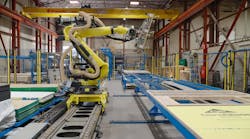Thanks to its integrated facility-management system, the London Health Sciences Centre (LHSC) in London, Ontario, Canada, functions much like a healthy human body, with an interoperable network of pieces and parts functioning in sync. The hospital’s facility-management system connects the hospital’s core building functions, including HVAC, security, life safety, and critical-point monitoring to enhance patient care and operational efficiencies across all of its facilities.
Much like a human body, however, achieving and maintaining optimal facility health depends on a balance of planning, maintenance, and flexibility.
The Road to Integration
LHSC has 7,400 staff members spread across three campuses—Victoria Hospital, South Street Hospital and University Hospital—that cover approximately 3.5 million sq. ft. of property. More than 1 million patients visit LHSC each year, and the hospital is a global leader in robotic surgery, cardiac care, multi-organ transplantation and clinical neurological sciences.
Previously, LHSC’s three facilities operated separately, running on disparate management systems that didn’t communicate with each other and left building managers without a complete view of activity across all campuses. This arrangement limited the efficiency of facility operations, including energy-management, safety, and equipment maintenance. Also, each system existed on a different server with its own software and workstation, which made it difficult to train building and maintenance staff.
The hospital took steps to cut energy costs and improve its infrastructure at the turn of the 21 Century. This created an opportunity to explore new levels of operating efficiencies through integration. With a multitude of systems and equipment across its three campuses, LHSC chose to build upon its long-standing relationship with Honeywell.
In 2003, Honeywell began installing energy-efficient building systems and making equipment upgrades. These projects were completed under an energy-performance contract that allowed LHSC to finance the improvements and new technology through the energy savings produced by the upgrades. Honeywell guaranteed the savings so the improvements didn’t impact operating budgets or require additional taxpayer dollars.
Central to this work was the installation of Honeywell Enterprise Buildings Integrator (EBI), an integrated controls platform that provides operators with a campus-wide view of all systems and equipment. EBI ties together HVAC, security, life-safety systems and critical point monitoring, enabling operators to view, access, and manage any system in real-time from any workstation. The goal of EBi is to increase efficiency, reduce operating costs, and improve business continuity.
According to LHSC Engineering Services Director Phil Renaud, the move to EBI set the stage for a new paradigm in the hospital’s approach to facility management.
“By looking at technology as a whole and establishing a central operations center for all three sites, we were able to move from a simple building management system to an integrated information system,” Renaud said. “Doing so opened up a lot of doors and enabled us to make an impact throughout the hospital, regardless of location or distance.”
A Secure Foundation
With this integration, the hospital began piecing the standalone areas and operations together. Doing so streamlined processes to create safer and more secure facilities, as well as more productive environments for staff.
LHSC took a phased approach to moving to EBI, starting with the integration of the hospital’s security operations. In 2004, the hospital upgraded its access control system at University Hospital, replacing the legacy card system on campus, which was nearing capacity and had limited scalability. The hospital chose to standardize on Honeywell technology with new cards and readers to control access to the hospital’s entrances and exits. Given the hospital’s planned growth, the new system made sense, Renaud said.
“We reached a point with the previous technology where we had to make a significant investment to expand it or replace it entirely with a system that offers unlimited growth,” Renaud said. “Given that EBI covers both building automation and security, it made strategic sense to head in this direction.”
As a critical part of a risk mitigation strategy, LHSC also installed Honeywell Asset Locator and Digital Video Manager—asset protection and closed-circuit television systems that are components of EBI.
The success of the upgrade at University Hospital prompted LHSC to expand the architecture to the other two campuses. Overall, the EBI system has grown to encompass 12,000 control points across the three campuses.
As the system grows, LHSC maintains secure grasp over all activity thanks to its centralized security and building operations center. Facility personnel are able to monitor operations through EBI’s single-window access to the multiple systems and databases that make up the security and building operations. The center boasts both bird’s eye and individual system viewing capabilities, allowing personnel to quickly isolate any problems, and respond quickly and accurately.
Additional Gains
Today, LHSC relies on the EBI architecture to optimize its building operations, benefiting everyone from the youngest patients to IT staff.
“The initial security installation compelled us to start looking at other systems and technology throughout hospital,” Renaud said. “Once we moved to an integrated platform, the scope quickly expanded and the benefits started to add up.”
For example, in the hospital laboratories, the integrated system helps LHSC meet specific accreditation requirements, which include regularly tracking and validating critical temperature points. Refrigerator and freezer units house samples and specimens that must be kept at precise temperatures. Previously, hospital personnel manually recorded each unit’s temperature, visiting every piece of equipment multiple times a day. The units are now equipped with sensors to help track and maintain the necessary environmental conditions. The sensors are tied into the EBI platform, and lab technicians are alerted with strobe lights or pager alerts if the temperatures move outside the set ranges.
This method saves considerable time and reduces human recording error. In addition, the new setup is useful for weekend monitoring and maintaining conditions within labs that are not constantly occupied throughout the day.
Collaborative Plans
Throughout the development and growth of its facilities and building systems, LHSC keeps Honeywell closely involved in all planning. Primary to this planning is an EBI roadmap jointly developed to leverage the integrated system’s scalability. Together, LHSC and Honeywell constantly update and revise the roadmap based on the hospital’s changing needs and overall expansion.
For example, LHSC is planning a 700,000-square foot addition to Victoria Hospital. The roadmap will provide guidance in identifying the network infrastructure necessary to support this growth. It also enables IT, engineering and other LHSC departments to budget for these additions.
“We’re always planning for the future,” Renaud said. “But as we get larger, it’s easy to lose track of all the different pieces and parts. This way, when we go to implement a new system, we know it will mesh seamlessly into our architecture and easily integrate with what we’ve already deployed.”
Because the building-automation systems are integrated onto the IT network, LHSC’s facility and IT personnel also collaborate to ensure proper convergence, especially as the EBI installation grows and requires more bandwidth. IT must determine how building and security systems will impact the network, and address potential issues, such as network exposures and security threats.
Fortunately, the EBI distributed-server architecture helps make the systems more resilient and easier to manage. LHSC originally housed its security and building automation systems on the same server. As the numbers of systems grew, however, the hospital found separating the servers improved both performance and uptime. Maintenance that takes the building-automation server offline, for instance, doesn’t impact the security system as well.
Sustained Success
While LHSC’s operations benefit from its unified building automation platform, it’s the behind-the-scenes efforts that keep all systems working properly. Through a comprehensive service agreement, Honeywell provides several technicians who monitor and maintain the various systems and equipment. The technicians cover all areas of service, from conducting preventive maintenance to keeping systems up to date with the latest technology enhancements and software patches.
“The size of operation and volume of activity is such that the technicians are working all the time, whether through remote monitoring or onsite maintenance,” Renaud said.
This support will be even more critical going forward, as LHSC plans to more than double the size of its EBI system.
“I think it’s a sign of our ongoing evolution,” Renaud said. “We started with a system backbone and built up a well-established network throughout our buildings, making it easier to move toward other advanced installations as a result. It’s essentially just a matter of adding applications now and running them back to our main core, an approach that presents significant economies of scale.”








